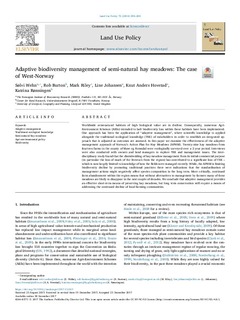| dc.contributor.author | Wehn, Sølvi | |
| dc.contributor.author | Burton, Rob J.F. | |
| dc.contributor.author | Riley, Mark | |
| dc.contributor.author | Johansen, Line | |
| dc.contributor.author | Hovstad, Knut | |
| dc.contributor.author | Rønningen, Katrina | |
| dc.date.accessioned | 2019-01-28T08:55:44Z | |
| dc.date.available | 2019-01-28T08:55:44Z | |
| dc.date.created | 2018-01-05T10:45:23Z | |
| dc.date.issued | 2018 | |
| dc.identifier.citation | Land Use Policy. 2018, 72 259-269. | |
| dc.identifier.issn | 0264-8377 | |
| dc.identifier.uri | http://hdl.handle.net/11250/2582525 | |
| dc.description.abstract | Worldwide semi-natural habitats of high biological value are in decline. Consequently, numerous AgriEnvironment Schemes (AESs) intended to halt biodiversity loss within these habitats have been implemented. One approach has been the application of “adaptive management”, where scientific knowledge is applied alongside the traditional ecological knowledge (TEK) of stakeholders in order to establish an integrated approach that is adjusted as outcomes are assessed. In this paper we examine the effectiveness of the adaptive management approach of Norway’s Action Plan for Hay Meadows (APHM). Twenty-nine hay meadows from fourteen farms in the county of Møre og Romsdal were ecologically surveyed over a 2 year period. Interviews were also conducted with owners and land managers to explore TEK and management issues. The interdisciplinary study found that the disembedding of hay meadow management from its initial commercial purpose (in particular the loss of much of the livestock from the region) has contributed to a significant loss of TEK – which is now largely limited to knowledge of how the fields were managed recently. While, the APHM is limiting biodiversity decline by promoting traditional practices there were indications that the standardisation of management actions might negatively affect species composition in the long term. More critically, continued farm abandonment within the region means that without alternatives to management by farmers many of these meadows are likely to disappear in the next couple of decades. We conclude that adaptive management provides an effective short-term means of preserving hay meadows, but long term conservation will require a means of addressing the continued decline of local farming communities. | |
| dc.language.iso | eng | |
| dc.title | Adaptive biodiversity management of semi-natural hay meadows: The case of West-Norway | |
| dc.type | Peer reviewed | |
| dc.type | Journal article | |
| dc.description.version | publishedVersion | |
| dc.source.pagenumber | 259-269 | |
| dc.source.volume | 72 | |
| dc.source.journal | Land Use Policy | |
| dc.identifier.doi | 10.1016/j.landusepol.2017.12.063 | |
| dc.identifier.cristin | 1536438 | |
| dc.relation.project | Norges forskningsråd: 230278 | |
| cristin.unitcode | 7501,0,0,0 | |
| cristin.unitname | RURALIS – Institutt for rural- og regionalforskning | |
| cristin.ispublished | true | |
| cristin.fulltext | original | |
| cristin.qualitycode | 1 | |
